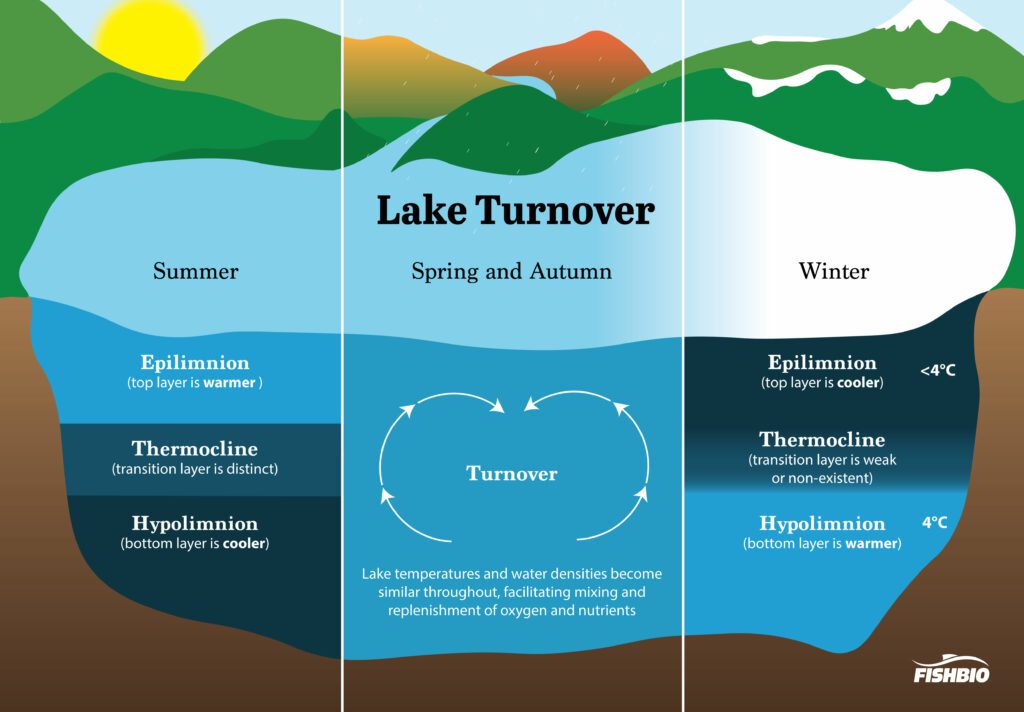Introduction:
Bass fishing is not just a sport; it is a science. Anglers are constantly studying the behavior of fish and the environmental conditions that influence their feeding patterns. One such phenomenon that often comes up in discussions among anglers is the water turnover. This tutorial aims to provide a scientific understanding of what it means when anglers talk about the water turning over from summer to fall to winter fishing patterns.
- The Science Behind Water Turnover:
Water turnover refers to the process of vertical mixing of layers within a body of water, including lakes and reservoirs. During the summer months, sunlight penetrates the surface and warms the top layer of water, creating a stratification of temperatures and oxygen levels. This thermal stratification is crucial for the survival of fish, as it provides them with suitable conditions for feeding and breeding.
As fall approaches, the air temperature begins to cool, initiating a series of events that lead to water turnover. Cooling air temperatures cause the surface water to lose its warmth, making it denser and heavier. Simultaneously, the cooler surface water sinks and mixes with the cooler water from the depths. This mixing process results in a more uniform distribution of temperature and dissolved oxygen throughout the water column.
- Impact on Bass Behavior:
Understanding the water turnover is essential for bass anglers as it significantly affects the behavior and feeding patterns of these fish. During the turnover, bass experience changes in water temperature, dissolved oxygen levels, and food availability. These changes prompt the bass to adapt and adjust their behavior accordingly.
a) Movement of Bass:
During the summer, bass tend to seek cooler, oxygen-rich areas such as underwater structures, vegetation, or shaded spots. However, as the water turnover occurs, the fish sense the changing conditions and relocate to deeper areas where they can find more stable temperatures and sufficient oxygen levels.
b) Feeding Patterns:
The turnover period can lead to increased bass activity and aggression due to their heightened metabolism in cooler temperatures. As the water temperature decreases, the bass’s metabolic rate increases, requiring them to consume more food to sustain their energy levels. This presents an excellent opportunity for anglers to target bass using various techniques.
- Adapting Fishing Strategies:
Anglers must adapt their fishing strategies during the water turnover period to maximize their chances of success. Here are a few effective techniques to consider:
a) Deep-Water Jigging:
Using a heavy jig, anglers can mimic the movement of a baitfish, enticing bass to strike. This technique requires precision and patience, as the angler must carefully present the jig near underwater structures or drop-offs where bass may be hiding.
b) Deep Crankbait Fishing:
Crankbaits that imitate injured baitfish can be particularly effective in attracting the attention of bass during the water turnover. Anglers should focus on casting near rocky areas, submerged trees, or underwater contours to entice bass into biting.
c) Vertical Fishing:
Vertical fishing with a drop shot rig or a Carolina rig can yield favorable results during the turnover period. These rigs allow anglers to present their bait at various depths, giving them the flexibility to target bass at different locations within the water column.
- Monitoring Water Temperature:
The water turnover does not happen overnight; it is a gradual process that can take several weeks, depending on the size and depth of the lake. Anglers must monitor water temperature and observe changes in fish behavior to determine when the turnover is occurring in their specific fishing spot. This can be done using a reliable thermometer or by consulting local fishing reports.
- Conclusion:
Understanding the science behind the water turnover is crucial for bass anglers looking to optimize their fishing strategies during the transition from summer to fall to winter fishing patterns. The changes in water temperature, dissolved oxygen levels, and baitfish behavior all play a significant role in determining bass behavior and feeding patterns. By adapting their techniques and monitoring environmental conditions, anglers can increase their chances of success and enjoy a rewarding bass fishing experience. Remember, bass fishing is not just about luck; it is about knowing the science behind the fish you’re pursuing.


